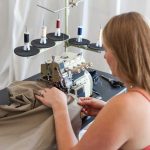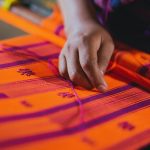When you consider the evolution of textiles, you can't overlook the significance of Jacquard fabric. Its origins trace back to the early 19th century, marked by the invention of the Jacquard loom by Joseph Marie Jacquard. This innovation didn't just streamline production; it reshaped the possibilities of intricate design in fabric, making it accessible to many. As you explore this topic, you'll find the impact on fashion and interior design is profound, but what might surprise you is how it set the stage for future technological advancements in textiles.
Table of Contents
Origins of Jacquard Fabric
Jacquard fabric originated in the early 19th century, revolutionizing textile production with its intricate patterns and automated weaving techniques. It emerged from the need for more complex designs in fabrics, moving beyond simple woven patterns. You mightn't realize it, but the creation of Jacquard fabric was influenced by the growing demand for unique textiles in fashion and home decor. Weavers sought ways to produce elaborate designs without spending countless hours on manual work.
As you explore Jacquard fabric's roots, you'll find that it draws inspiration from earlier weaving methods, particularly brocade and damask. These fabrics showcased beautiful patterns but required significant time and skill to produce. The introduction of Jacquard fabric allowed artisans to create intricate designs more efficiently, making high-quality textiles accessible to a broader audience.
The early use of Jacquard fabric quickly gained popularity among the upper classes, who appreciated its luxurious appearance. It wasn't just about aesthetics; the fabric's durability and versatility made it suitable for various applications, from clothing to upholstery. As you delve deeper into its history, you'll see how Jacquard fabric set the stage for modern textile innovations, blending artistry with technology in remarkable ways.
The Invention of the Jacquard Loom
In 1804, Joseph Marie Jacquard unveiled his revolutionary loom, transforming the way intricate patterns were woven into fabric. This innovative machine utilized a series of punched cards to control the weaving process, allowing for the automatic production of complex designs. You can imagine how this invention not only simplified textile creation but also paved the way for future technologies.
The Jacquard loom introduced several key features:
- Automated Pattern Control: The use of punched cards meant that patterns could be easily modified and reproduced.
- Increased Efficiency: Weavers could produce detailed designs much faster than traditional methods, saving time and labor.
With these advancements, the Jacquard loom became a pivotal instrument in textile manufacturing, laying the groundwork for the mechanization of the industry. By harnessing this technology, you can appreciate how artisans and manufacturers alike gained new creative possibilities, ultimately changing the landscape of fabric design forever.
Impact on Textile Industry
The introduction of the Jacquard loom revolutionized the textile industry by enabling mass production of intricate designs, significantly altering manufacturing processes and market dynamics. You'll notice that this innovation allowed for the creation of complex patterns with far less labor than previous methods. By automating the weaving process, the Jacquard loom not only improved efficiency but also reduced the cost of production.
As a result, textiles became more accessible to a broader audience, democratizing fashion in ways never seen before. You can see how this shift impacted consumer demand, as people sought out beautifully designed fabrics for their homes and wardrobes. Moreover, the Jacquard loom paved the way for future innovations in textile manufacturing, leading to the development of even more advanced machinery.
With the ability to produce a variety of designs quickly, manufacturers could respond to changing market trends more effectively. You might even appreciate how this flexibility encouraged creativity among designers, leading to a rich tapestry of styles and patterns that still influence the industry today.
Evolution Through the Ages
As textile technology advanced over the centuries, the Jacquard loom played a crucial role in shaping how fabrics were designed and produced. This innovation allowed for intricate patterns to be woven into fabric with greater efficiency and precision.
You'll see how the loom transformed textile manufacturing and design:
- Increased Complexity: The Jacquard loom enabled artisans to create complex patterns that were previously difficult or impossible to achieve by hand. This led to a surge in decorative fabrics that enhanced clothing and home textiles.
- Mass Production: With the ability to automate pattern weaving, the Jacquard loom paved the way for mass production. This meant fabrics could be produced faster and at a lower cost, making them more accessible to the average consumer.
Jacquard Fabric in Modern Design
Jacquard fabric continues to influence modern design, bringing rich textures and intricate patterns to contemporary fashion and interiors. You'll find this versatile material in everything from elegant dresses to stylish upholstery, making it a favorite among designers. Its ability to create complex designs using a variety of yarns allows for endless creativity, so you can express your personal style in unique ways.
In fashion, Jacquard is often used to add depth to garments, elevating simple silhouettes into statement pieces. Whether it's a bold floral pattern or a geometric print, this fabric can transform any outfit into something extraordinary.
In interiors, Jacquard's luxurious feel and visual appeal make it ideal for curtains, cushions, and upholstery, giving your space a sophisticated touch.
With advancements in technology, Jacquard weaving has also become more accessible. Digital printing techniques now allow for even more intricate designs, ensuring that you can find something that fits your aesthetic perfectly.
As you explore modern design, you'll see how Jacquard fabric continues to inspire and innovate, proving that its rich history is still very much alive today.
Frequently Asked Questions
What Materials Are Typically Used to Create Jacquard Fabric?
Typically, you'll find jacquard fabric made from cotton, silk, wool, or synthetic fibers. These materials allow for intricate patterns and textures, giving the fabric its distinctive look and making it popular for various applications.
How Does Jacquard Fabric Differ From Other Woven Fabrics?
Jacquard fabric stands out because it uses complex patterns woven directly into the fabric, unlike simpler woven fabrics. This technique allows for intricate designs, making it more versatile and visually appealing in various applications.
Can Jacquard Fabric Be Eco-Friendly or Sustainable?
Yes, jacquard fabric can be eco-friendly or sustainable if produced using organic fibers and environmentally friendly dyes. You should look for certified brands that prioritize sustainability to ensure your choices align with eco-conscious values.
What Types of Patterns Can Be Created With Jacquard Fabric?
You can create intricate patterns with jacquard fabric, including floral designs, geometric shapes, and complex images. The loom's versatility allows for endless creativity, letting you customize textiles to suit any style or aesthetic preference.
How Do I Care for Jacquard Fabric Items?
To care for jacquard fabric items, wash them gently in cold water with mild detergent. Avoid bleach, and air dry or tumble dry on low. Iron on low heat if needed, ensuring you protect the intricate patterns.
- Tetron Fabric for Marine Applications: Durability and Use Cases - June 18, 2025
- Tetron Fabric for Outdoor Furniture: Weather Resistance and Care - June 18, 2025
- Tetron Fabric for Wall Coverings: Style and Application Tips - June 18, 2025





